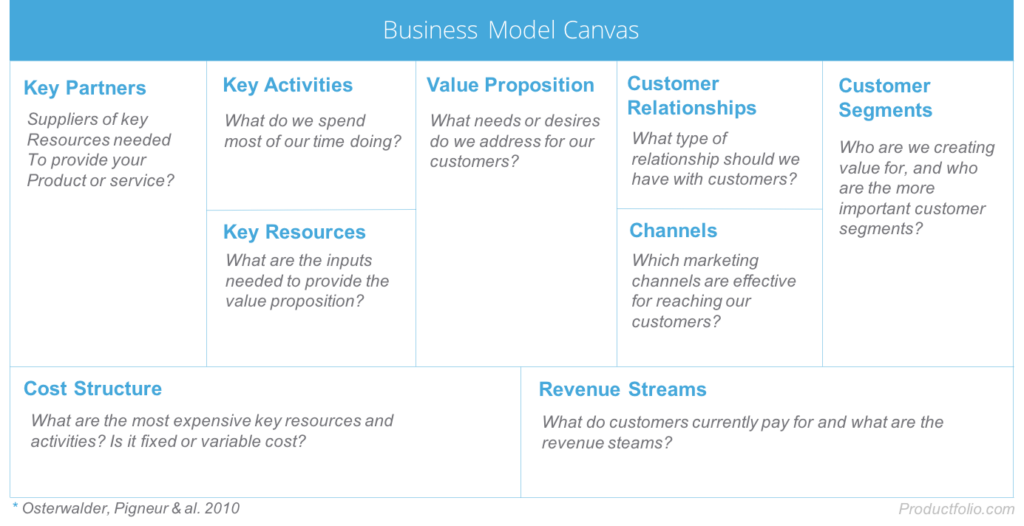What is the Business Model Canvas?
The Business Model Canvas has risen to popularity as a simple “lean” way to define a business model. The business model is an expression of business strategy, not product strategy … since Product strategy supports business strategy, it can be a very useful tool for Product Managers to think through. This Business Canvas Model helps Product Managers to better understand the mechanics of the business and how the product can best support the business.

In the late 2000’s Alexander Osterwalder and a team of 470 co-creators published the “Business Model Canvas”. Osterwalder is a Swiss business theorist, who is best known for his work in doing business modeling. The Business Model Canvas is broken down into nine segments Key Partners, Key Activities, Value Proposition, Customer Relationship, Customer Segment, Key Resource, Distribution Channel, Cost Structure, and Revenue Stream.
The 9 Segments of The Business Model Canvas
Key Partners – Who are your key partners/allies/vendors and what are the motivations for this partnership?
Key Activities – This segment highlights the most important activities that your company or product is executing in regards to the value proposition.
Value Proposition – The collection of services your product offers to meet customer needs. Simply put, a Value Proposition determines what are you building and for who.
Customer Relationship – You need customers for your product to be successful, and in this segment, you’ll determine how you get customers, how you keep customers and how you’ll grow the number of customers for your product.
Customer Segment – For a product to be successful it’s important to determine the types of customers you’ll be tailoring your product towards, and that’s what the segments helps you to identify.
Key Resource – What resources will be required to develop your product and market it to your customers.
Distribution Channel – What channels are best for your users to be reached? How will these channels be integrated into your customers’ routines?was
Cost Structure – This segment goes over the costs/expenses of developing and operating your product.
Revenue Stream – What are the various avenues that you can earn revenue from your users. Most products and business models have multiple revenue streams. Direct sales and subscriptions are common revenue streams for products.
How to Create a Business Model Canvas
Creating a Business Model Canvas is a great exercise for a team to work at the start of developing a product to ensure that everyone has a clear roadmap going forward. When working with your team it’s best to divide your 9 segments into the three working sections to streamline the exercise. Start with the upper right blue section, Value Propositions, Customer Relationships, Customer Segments, and Channels. In this section, you’ll want to cover everything with your team from pain points and pleasures to potential risks and jobs to be done. The left side (the pink section) covers Key Partners, Key Activities and Key Resources. In this area, you’ll determine the feasibility of your model. Do you have the right suppliers available to you, and the resources needed for the product to be successful? Lastly, you’ll move to the bottom row, Cost Structure and Revenue Streams which will ensure the viability of the product that you and your team are developing.
The Business Model Canvas is a framework that aims to shorten the product development cycle and rapidly discover the viability of a product or business. It is also a really great way to educate a product team about the Business they support. The visual chart allows product teams to collaborate in a workshop-type format, to level-set and understand the business.


